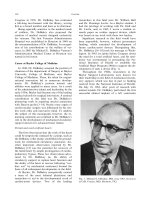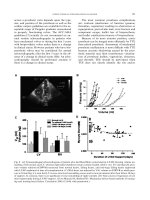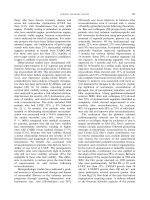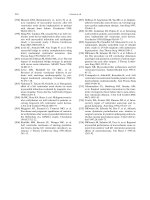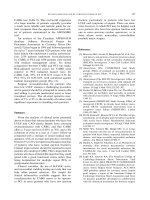Syndrome of inappropiate antidiuretic hormone release in heart failure
Bạn đang xem bản rút gọn của tài liệu. Xem và tải ngay bản đầy đủ của tài liệu tại đây (11.78 MB, 26 trang )
Syndrome of inappropriate
antidiuretic hormone release
(SIADH)
in heart failure
Nguyễn Thị Hồng Anh, MD
——
=
"39L50
1/3"
Phòng:8
\ MEDIC, /
BENH AN
Họ tếi
IQuét QR Code dé xem KQ]
lam sinh: 1988- Nam
Dia ch
ˆ
Mở
% Baso
@ Neu
SEN
—T
# Lym
# Mono
|, Q. BINH TAN, TP.
Nghé nghiệp: kỹ sư
[_—
# Eos
# Baso
RBC
Số thẻ BHYT:
Huyết áp: 113/71 Mach: 81 Cao: 168cm; Năng: 65 kg; Nhiệt dé: 37.00°C
Hb
Tiến sử bệnh:
Hct
Mưa
0.4
2m
1.79
[sano
rar cout]
(0-15%)
G7 7.0) 1079.
(1.0- 4.0) 10^9/L
0.54
(0.1 - 1.0) 10^9/L
0.02
5.36
(0 - 0.2) 10^9/L
(3.80 - 5.60)10^12/L
16.4
(12 - 18 g/dl)
0.08
491
(0 - 0.5) 10^9/L
(35 - 52%)
Lý đo đi khám-
MCV
91.6
(80
- 97 fL)
Lẫm sàng: - kiếm tra tổng quát
MCH
30.6
(26
- 32 pg)
ie
ane
RDW
PLT
MPV
URINARY ANALYSIS:
:
CHỈ ĐINH:
+ NS da diy - tá tring: VIEM DA DAY
+ MRI So Não: Không thương tổn não táng trên và đưới léu
1)Chemistry (Sinh Ha) :
Khéng bénh ly chat trắng não.
Không viêm xoang.
+ Khám CK Tim mach: TD BENH CO TIM DAN NỞ-EF=48%-HỞ VAN
Glucose
Biliru
2 LÁ 1/4
11.7
235
96
*
k4
NEG
N
=
(11.0 - 15.7%)
(130 - 400)10^9/L
(6.30 - 12.0 1)
(mmoYL)
‘
"
+ XQ Lồng Ngực Thẳng [In Giấy]: Không phát hiện bệnh ly trén phim XQ nguc (Normal chest film)
+ SA Tim Mau: THEO DOI BENH CO TIM DAN NO
= Bans
eres GIAM NHE CHUT NANG TAM THU
Ketone
Spe-Gravity
——
NEG
1.012
a
(mmoVL)
(1.005-1.030)
(NEGATIVES
+ SA Tuyến Giấp mau: HIEN CHUA GHI NHAN BAT THUUNG TREN SIEU AM VUNG C6 VA TUYEN GIÁP.
+ SA Bung Téng Quét Mau: SOI THAN PHAL GAN NHIEM MO.
pH
Protein
65
NEG
(4.6-8.0)
(g/L)
+ Điện tắm đó (ECG) thutmg: GHI NHAN SONG T DET/AVL
- XÉT NGHIỆM: loa đó nước tiểu (K, Na, Ca, Cl), HIV Ag / Ab Combo, Nhóm máu ABO ( GS + Rh ), lon đồ chung,
HP test ( IgM ), HP test ( IgG ), ADH, NFS (C.B.C), Glucose (FPG), AST (SGOT), LDL.C, Téng Phan Tich Nude Tiéu,
ALT (SGPT), Creatinine/m4u (eGFR), Triglycerides, hsCRP, GGT, Uric acid, HBsAg (Dinh Tinh), Anti HBc Total,
Anti HCV (Thé hé 3), Anti HBs, TSH (Thé hé 3), Free T4
KẾT QUÁ XÉT NGHIÊM:
Leucocytes
Color
Clarity
2)Urine Sediment (C4n Ling):
NES(C.B.C)(CƠNG THUT MAU)
WBC
(4.0-10.0)10^9L
% Men
@0-74%)
-
sim
% Eos
Urobilinogen
Nưưce
:
i
(19-48%)
(0-7 %)
—____—_—
—
Calcium oxalate monohydrate
Calcium oxalate dihydrate
Amor.Phosphate
NEG
NEG
(pmoVL)
(NEGATIVE)
NEG
Yellow
(NEGATIVE)
-
(particles/pL)
:
a.m
: 0-15 :
Clear
1
o
0
°
(0-6)
(0-6)
(0-6)
|
*#NxerNGeMĐM
kếroU
[|
(0.5 - 230 mmol/L)
1.13
—
"¬
scorusn:
SGPT (ALT)
21.30
==
U/L; F < 36 U/L)
(M < 55 <=.=mr
19.23
3. 30UA)
Creatinin/Serum
1.07
(M: 0.6 - 1.3; F:0.5 - 1.1 mg/dL)
SiH
/min/1.73 m*)
(= 90 mi
.
NEG S/CO 0.180
(071-185ngd),
(index<1;S/Co<1)
ˆ......
(0.51 - 4.94 TU/mL)
nae
—— —
ee
`.
”ò>ồ—......1
————hs————
Troponin-T
(Roche) —
{> 10 mUl/mL)
380.0
(S/Co > 1)
POS S/CO 0.256 L
ADH (Anti Diuretic Hormoae) (Elsa)=—==>(_
nae
5.93
NEG < 5 U/mL
GZ 3545 mt
Chẩn đoán: VIÊM DA DẠY 1IP+, THEO
DÖI TRÀO NG
s
(/À 77/7277. ey KẾT QUÁ XÉT NGHIỆ
ee TH ee Serre
142278H)
Gf€e<1:Imdx<Ð
(< 14 ng/L)
(< 20 U/mL; GRAYZONE: 20 - 30)
(< 30 U/mL; GRAYZONE: 30 - 40)
(10-100 pg/mL)
DAY-THUT QUAN, ROI LOAN CHUYEN HOA MO,
GAN THẤM MỠ,TĂNG ACID URIC , SỎI THẬN PHẢI /theo đối bệnh cơ tìm din né, thất trái đăn nhẹ „ có giảm nhẹ
chức năng tâm thu đã có toa /TĂNG ADH rất cao (nhiễm cũ HBV có anti HBs cao
(BM..T QUA
Ema arin g medi abc. lab.com:vn
.
Pee
| yeu cau: NGUYEN.T.H.ANH (PK-TQ)
ET
aces
TÊN XÉT NGHIỆM|
KETQ
[KHONG THAM CHIÊU|MÃ
QUA
=
=
CHUVETHOC/BONGMAU- HEMATOLOGY COAGULATION. a
| ®@— Nhóm máu (ABO +TRUỢ
ABO Group;
°° »}»}
|
Sl eee
=—=.-...........c..........
rẽ Á
FS...
Sas .
2 Le
(ieee,
“1. SINH HOA- BIOCHEMISTRY =
ee
.
a
NV
XU
T
KOSC
E:
|ONOGRAMM
er ee ee
oe
| ee
,
gag a
Ea <2 22s6-852222-==2. Be Soci ns eee
| ee
ˆI@NOGR,
*
Độ Lọc Cầu Thận (CKD-EPI)
6a
ooo ee ca
qia~)....|©©6l\a
204
hs CRP
|
(M4: 3.4-7.0; F: 2.45.7 mg/dL)
Z04H
Uric Acid/Serum
HP Test-IgG (Elisa)
HP Test-IgM (Elisa)
(<360mmolt)
3.18
LDL Cholesterol
=..
(96-108mmoll)
G90-s9ommap
105.0
5.44
Giucose (FPG)'
ppl
21-260 mmol)
2.38
=
a
tia chi:
—
————
(3.40 - 5.1 mmol/L)
—
3.92
K=
_
(0-10)
1
Cells
CÁ
we
——
a
:
:
=
aaa
*v+~~~
lay mau:
n0 205
PII2
HÒA HẢO
Ha ph Naas
cm TH
Km“:
[| KHOẢNGTHAMCHIẾU | „cv.
a ˆ Nai
39 i ad
oa
Bất kỳ: 119.13 mmol/L
)
— K/Urne Bat ky : 78.59 mmol/L (50-100mmol24n..
|
[2
%CaUrine Bấtkỳ:l45mmolL csca 250 mmol340) =
———_ TSMUD.Cl/Urine Bất kỳ: 181.85 ‘mmol/L (0
“2M6Ð H Gis395nmOsmol/Kg) Lhe
_ Áp lực thảm thấu máu —
“Áp lực thâm thâu nệu
ˆ HN. MIỄN DỊCH- IMMUNOLOGV
|,
OT
642. 0- i
`
HIV AgAb Combo — NEG S/CO0050
Bortee mOsmol/Kg)
HỆ
CONG TY TNHH
De
chi : 254 Hoa
Y TE HOA HAO
- PHONG KHAM DA KHOA
(Tés cl - TRUNG TAM CHAN OOAN
Hảo, P.4, Q.10,
TP HCM - DT : 86.028.39270286
; FAX - O28. 3927243
Emall -
CƠNG TY TNHH Y TẾ HĨA HẢO ‹ PHỊNG KHAM ĐA KHOA (Têo củ : TRUNG TẮM CHẤN ĐOÁN
Đa chỉ : 254 Hòa Hảo, P.4, Q.10, TP HCM - ĐT : 028 39270284 ; FAX : O28. 3927243
Y KHOA MEDIC)
Email - hoahac254@moedic
; Website - www.mediccom.va
SIEU AM
TIM
May: ALOKA
MAU
ANH
That
Phis-
xuất tống
ngắn:
FS:
Tâm trương: ïVSS: 6
Tắm trœợơ«e LVDd:
66
trái:
Tắm trương:
sáu:
EF:
PVWd:
%2
Tam the: [VSs: 8
Tam the: LVDS:
33
Tâm te: PWs
1Ø
@
%
(Tetchholt)
DMC:
AO-
28
Vịng
mm
ĐM ph»ểt: Gốc: Asm =
van 3 lá
(P.
=28mmHgì
Nà trái
..y
Vách liên sài
Màng ngoài ti
DOPPLER
EA
Vtxsax
chieh
Jp
hi da
22mm
2- Van bai lá dày hở 1/4, van ĐMC bình thường
Mace Dee Ghee
Trai
1. Deeg ques wan 2 Le
|
46 mm
3- Khơng tràn dịch màng ngồi tìm
SIEU AM
| He wee
Chức năng tâm thu thất phải bình thường TAPSE=
mm
mm
mm
(Sampsan)
Phải
Thain:
|
1-Thất trái dân nhẹ. Các buồng tim khac trong giới hạn bình thường LVDd=
AVO:
Vòng van 2 lá: Ann =
tối đà
TIM MAU
Động mạch
chủ ngực kích thước bình thường
Chiếc
cđàa há trước vam
2 há:
View tie
+ 2D
27
Đường kinh gGc van
Nhi trai: LA: 30
Đà
KIEM TRA
VUNG KHAO SÁT : SIFU AM
Giam động vách liên thất Chức năng tắm thu thất trái giảm nhẹ EF= 48-52%(Teichholz)
Thanh sau thất trái:
Rét
T™
[Quét OR Code dé xem KQ]
33tuốế
Nam
G HOA B, Q. BINH TÂN,
Lam sang
20
Vách liên thất
Đường kính thất
Phân
TIM
3923673
08:55
Ho va tén
Đa chỉ
ALOKA -ProSound a6
32 toối
Nam
B, Q. BINH TAN, TP. HCM
BV chi dinh
MEDIC
SIEU AM
-ProSound a6
ID
May.
THỊ HONG
Y KHOA MÉĐIC)
moedic.com.va
KET QUA SIEU AM TIM MAU
"3923673"
ID
Họ và tên
Dia chi
Bác sĩ chỉ định : NGUYÊN
com.w ; Website : www.
as
Coeak
2 Le: Mere đệ:
Vee
1 Hee vam 2 lá:
tms
1.6
1/4
Trương
menlls.
2. Deeg
que wee DMC:
ink
Truøg
Thee gan
ms Ce
Duận tách bố vaø
3Ý. Dong qua van 3 láivi Hẻ vam
View tie Ohi da diag bé wae: max
Áo lực Use Gu DM ph: PAP:
Qh} chdeh
Jp thi da Cp
3 Le
oqpQx:
MAU
Veseu
dink:
24
28
as
=zaliq
tim thu
ragatig
<=)
Mex độc 1/4
rae
earmlig
Via
DS
|
|
ic
dt
da
Vex
chédah
4p thi Ga
a1
Creek
ma
S
Trương
mưếiog
bish
as
Trưng bàyh
tamhicg
) hep wan DMC:
Dije tich B vam
c—n(^2)
) ie wae DMC: Mee dé:
PHT
mms
TDOE
Dorn, Lind ph
eqecx
ra
Mex 6) Lan ong giều!( spe
4. Dòng qua và DM PRR:
Vee tbc the Ga: Viewax
es
ze
Độ chữnh áo tết đa: Cứ:
Trang banh: Can:
Tá thuếu
mig
( 1 Hẻ van ÐM phối:
Áp bạc ĐĐ4 phố TH: PAPYeaøx
=zzliq
Ap bec DM ph, tám trương
gumliq
( ) Hep wae DM Pha:
3. Dòng bất thường
qua vách liên thất
6. Dòng bất thướnng qua vách liên nhí:
7. Các vấn đề khác
KẾT LUẬN ;
THEO DOI BENH
CO TIM DAN NO
THAT TRAI DAN NHE GIAM NHẸ CHỨC NANG TAM THU
HỞ VAN 2 LÁ 1/4
Đé nghị :
SIÊU ÂM LAI 1 THÁNG SAU
Tp. Hó Chí Minh, ngày 05/09/2020 09:05
(Bác sĩ đã ký)
X
Khos Tim Mach (CTY TNHH Y TE HOA HẢO), ĐT: 84 02839270284
Khám Chuyên Khos - Siu 4m tim (mau Doppler), si¢u 4m TEE ECG Holter,
MSCT.CAT (chup mach vanh). DSA Déng mach vanh - MRI Tim
Holter huy&
ap,
ECG
Tress Test
Đây là kết qué dang sé trad ty động tứ hệ tháng Mădic Bắn giấy Rác số đã ký trả bệmh mhậm
Le
a
Le
CÔNG TY TNHH
De
chi : 254
Hoa
Y TE HOA HẢO
Hao,
P.4,
Q10, TP
Email - hoshao2}
Khoa
: SIÊU
AM
TONG
- PHONG KHAM ĐA KHOA (Tộc củ - TRUNG TÁM CHẤN OOAN Y KHOA MEDIC)
HCM - ĐT : 028
; Wetsite - www
QUAT
. Phong
.39270284
medic
; FAX:
G24
32272543
com.va
12 - Máy:
ALOKA
-ProSound
œ5
CONG TY TNHH
De chi : 254 Hoa
KẾT QUẢ SIÊU ÂM MÀU
ID
32tudi
Dis chỉ
Lam sang
BS chỉ định
BV chả định
VUNG
GAN:
:MD
Không
SIEU
AM
BUNG TONG
QUAT
to, bở đéu, cấu trúc phản 4m dày, giảm 4m vùng
Cấu trúc, kích thước
- www.
- Phong
xâu, khơng
sang thương
bình thường.
LÁCH:
khơng
Y KHOA MEDIC)
ALOKA
-ProSound
œ5
¡09:44
«G HOA B, Q. BINH TAN.
32tuấ
VUNG
Nam
[Qt OR Code dé xem KQ]
TIEU DEM
BS HĨNG ANH
MD
KHAO
SAT:
SIEU AM
VUNG
CO
MAU
TUYẾN GIÁP: kích thước bình thường, nén giáp cấu trúc echo diy, ding nhất, khơng nhân giáp, phần bố mạch
máu bính thường.
to, đóng dạng
- THẬN P: có vài sỏi # 3-5men, khơng
ứ nước THÂN T: không sỏi không ứ nước.
- BẰNG QUANG: không sỏi, không bướu, vách mỏng,
Tiền liệt tuyến: không to.
Déng mach chủ bụng khơng
12 - May:
co - TRUNG TAM CHAN ĐỐN
G28 39272313
com.va
Dis chi
BV chỉ định
khu trú.
medic
ID
Lam sang
BS chỉ định
MAU
- MẤT: tới mặt không sỏi, vách mỏng, Đường mặt trong gan không dăn. Ống mặt chủ không sỏi không dân
- TUY:
; Website
Ho va tén
: TIỂU ĐÊM
BS HỒNG ANH
SAT:
com.
KET QUA SIEU AM MAU
[Quét
QR Code dé xem KQ]
Nam
IG HOA B, Q. BINH TAN,
KHAO
Y TE HOA HAO
- PHONG KHAM DA KHOA
(Tés
Hao, P.4, Q.10, TP_HCM - ĐT : 028 39270284 ; FAX:
- hoahao254@moedic
Khoe : SIEU AM TONG QUAT
°3923673°
09:37
Họ và tên
Emad
- HACH CỔ: không hạch bệnh lý.
TUYẾN MANG TẠI, DƯƠI HAM, DƯƠI LƯƠI: bình
PHẦN MẾM CỔ (Da mỏ dưới da cắn cơ), THỰC QUẦN CỔ: chưa thấy bất thường.
phinh.
- Ascites (-). Khéng hach 6 bung.
Không tràn dịch màng
phối.
KẾT LUẬN ;
HIEN CHUA GHI NHAN BAT THUONG TREN SIFU AM VUNG CO VA TUYEN GIAP.
Tp. Hé Chi Minh, ngay 05/09/2020 09:46
(Bác sĩ đã ký)
SOI THAN
PHAL GAN
NHIEM
Bx. Trấn
Thi Trúc
MO.
Tp.
Phương
Hé Chi Minh, ngay 05/09/2020 09:37
(Bác sĩ đã ký)
Day là két quá đang số trả tự động tứ hd Chang Medic. Ban giấy Eác số đã ký trả bệ mhk mhận.
Day là két qué dang
+6 tra ty déng
tir hé thang Medic.
Ban
qiáy Eác sĩ đã ký trẻ bệmh
whan.
CONG TY TNHH
Khoa : Khoa Nội Soi Tiêu Hóa - Máy: Olympus GIF240
KẾT QUẢ NỘI SOI
[Quét QR Code dé xem KOI
:
ID
Đo và cơn
`
Địa chỉ
0. BÌNH
TÁN,
MEDIC
>
VUNG
>
KHAO
4
SAT:
TP.
STT
s 252
: 32
((đ
:
:
aQRS:
60
QRS Complex
ee
ST Segments
TVớứave
7070/03/18
7070/03/18
==
=
=
Nam
rếegay 2K : U2/U%/đUU U%:22
:
PWave
nhỏ. bệnh thường
lớn: bình thường
“
;
Tuổi
- Mỏn vị: trịn đều, không hẹp
ee
-
Bệnh nhân
Hang vi - Tiến môn vi CO NHIEU CHO VIEM DO (PHOTO )
SE
-
PHAN TICH ECG (ANALYSIS) :
ng
Bo cong
Bở cong
-
IIIIIIIIIIIIIIIII
ID
Lâm sàng
binh thuong
<9 ink i
-
Bác sĩ chỉ định
Đường
Z2 cách cung rang : 40 cm
+See
Tam vi:
Oign thogt :O28.39270284;
Fax: 02839272543
nà
4
NS DA DAY - TA TRANG
1. Thực quản: niềm mọc bình thường, không hẹp, không bướu.
2.
- PHONG KHAM DA KHOA
DIEN TAM DO .- DIEN TOAN
(DIGITAL ELECTRO CARDIOGRAPHY)
Lam sang
HOI CHUNG DA DAY
Bác sĩ chỉ định : ANH
BV chỉ định
Y TE HOA HAO
Địa chỉ : 254 Hòa Hảo, Phường 4, Quận 10, TP. HCM
|
Rhythm: XOANG
:Êxt Leads
:Pre Leads
: Ext
>
on.
Leads
=
UWave
KET LUAN
[Quét
Interval: PR: 0.12
QRS:
0.08
QT:
0.36
BT
BT
=
:Pre
Leads
EBT
:Êxt
Lleads
T DẸT/AVL
:Pre.leads
1:
Rate: 65
EBT
8ST
:Ext Leads
BT
:Pre.leads
ST
: GHI NHẬN SĨNG T DẸT/AVL
QR
Code
để xem
KQ]
Tp. HỒ Chí Minh, ngày 05/09/2020
(Bac si da ky)
10:25
c—
Tp. Hé Chi Minh, ngay 18/09/2020
BS. Nguyễn Thị Bạch Tuyết
(Bác sĩ đã ký)
Bs. Nguyễn Hóng Vũ
Day
là két quá đang +6 tra ty dbng
tir hd thang Medic. Ban gidy Bac si 24 ky trả bệmhk whan.
Họ và tên
-
Đa chỉ : 7
8% cv định : 8s. Nguyễn Thị Hồng Anh
i:Nam
sáK†T(
Ngày OK : 05/09/2020
Lâm sàng - - kiểm tra tổng quát: thỉnh thoảng cảm giác trào ngược có dùng thuốc
Giớ ĐK : 08:51 AM KQ : 09:49 AM
cách 5 ngày- hay tiểu đêm
XQ Lồng Ngực Thẳng [In Giấy]
Thành ngực
Màng phối
Trưng thất
:_ Khổng có ánh bất thường
:_ Khơng có ánh bất thường
: Khơng có ánh bất thường
Tim
: Khổng có ánh bất thường
Hưyết phế quán
:_ Khổng có ánh bất thường
Động mạch chủ
Phối
Cơ hồnh
nghị
:
rẻ
cac
:_ Khơng có ánh bất thường
:_ Khổng có ánh bất thường
:_ Khổng có ắnh bất thường
eee
Hướng
dẫn lấy ảnh số:
- Để lấy hình ảnh XQ dạng số, sử dụng điện thoại thơng minh có phấn mềm qt QR Code (QR Code Scanner)
hoặc các phấn mém Zalo, Viber... quét mã code được in phía trên.
- Android: Vào mục tải ứng dụng (CH Play hoặc Play Store), tim QR Code Scanner.
- iOS: Từ iOS7, dùng camera quét, điện thoại đời củ, vào Apple Store, tim QR Code.
Ngày 0S tháng Ø2 nšm 2020
Bác Z X Quang
kỷ
Bs. Nguyễn Ván Công.
HUAN. PHAN VAN
CONG TY TNHH Y TE HOA HAO « PHONG KHAM
A
4
DA KHOA
Dia chi: 254 Héa Hao, Phudng 4, Quin 10, TP. HCM
Diện thoại : 028.39220284 ; Fax : 028.3927243
Email : hoahao254@međic.com.vn ; Website : www.øedk cơm vụ
MEDIC MRI REPORT
STT
Bệnh nhàn
Địa chỉ
ÿ ĐK : 18/09/2020 11:03
Tuổi: 32 Nam
............\B Q BINH TÁN, TP. HCM ‹
Bic sichidink
: BS. NGUYÊN THỊ HỐNG ANH
Bệnh viên
: MEDIC
Vung
Kết quả
: MRI SO NAO
: Nào bệnh nhắn được khảo sát qsa các mặt cất theo những
T2 FLAIR, Axial DWI. Khong tiêm theốc lương phản
XOANC
LYDOKHAM
Máy
[Quét QR Code đế xem KQ]
Khoa : PK
: KT
: GE EXPLORER
Khóng tiêm tương phảa
chuối xung: Sagittal T1W1; Axial T2W1,
Axial
Các xoaag ham, tran, sang, budm hai bên sang đều
¢ khoang canh
hae hal bên trong
Vom hau va
Cac tế bảo châm hai bên sing déu
HO SAU
Khỏeg phát hiện bất thường tín hiệu nha mó tiếu sảo, thân não trén TIW], T2WI,
Nào thát IV ở giữa, khóeg giáa. Các bé dich obo tey quanh than nảo bình thưởng
TANG TREN LEU
Khéag théy thuong téa hay tin hide bat thedng trong ahu mỏ nảo trên các
bệnh
lý
chá
chuối xung khảo
àinà
đạng,
Ech
xuất huyết não.
thước
Khôeg
dị dang mach mau ndo.
He
thing
thường
*** KỆT
LUẬN
Khoog thương ton nào táng trên và đưới lêu
Khỏeaq bệnà tý chát trắng nảo
Khóagq
viêm
Khơng
ndo that biah
ti
Cáu tréc đường qiữa khơng
bát
sát.
trang
hiệo máu tạ hay
¡
T2FIAIR
Yồng
Tp. Hé Chi Minh, ngey 18/09/2020 13.07
(Bac si da ky)
Bs. Nguyễn Thành Đúng
Patient’s problem:
Chan dod: TD BENH CO'TIM DAN NO-EF=48%-HO VAN 2 LA 1/4
THUOC
ĐIẾUTM:
(Gón 2 lạ thuc)
Ì. Furosemide 40mg. (Furvsemide)
07 Vien
2, Bonsartine 25mg, (Losartan 25mg)
07 Vien
Ngoy uúng 01 Win, ldn 01/2 wien (sang)
Ngdy wong OF lin, dn 01/2 viên (chiếu)
LOLDAN BS
13:12
TpHCM, ny 05/09/2020
Bac
si dieu tr
Bs. Duong
Phi Som
* PKDK Hod Ho khing cé phing Khém bén ngodi, vu ling vio trong ing ký khán,
+ Tái khám xin mang theo don thude nay, phim va day du ho sơ củ.
1. Dilated cardiomyopathy with low
ejection fraction
2. Extreme high ADH but nocturia
(young men: 32 years old)
3. High serum osmolality,
hypocalciuria
4. Metabolic disorder (high LDL-C,
fatty liver, hyperuricemia , kidney
stone)
5. Gastritis and GERD
Be
Vasopressin
¢ Arginine vasopressin (AVP)=antidiuretic hormone, is a nonapeptide
secreted from the posterior pituitary gland.
¢ The primary stimulus for the secretion of AVP is a rise in serum
osmolality. The central sensor for serum osmolality, or osmostat, is
located in a small, discreet area of the hypothalamus just anterior to
the third ventricle. The osmostat controls the release of AVP,
stimulating water retention and the thirst response.
¢ AVP is also a key element in the regulation of volume. AVP is
released in response to a diminished effective circulating volume or
diminished blood pressure. In contrast to the osmoregulatory
system, which relies solely upon a central sensor, volume regulation is
anatomically diffuse and involves many sensors.
° The downstream effects of AVP are mediated by two cell-surface receptors, V1la
an
,
- The Via receptor can be regarded as the cardiovascular AVP receptor. V1a receptors
are predominantly located on the surface of vascular smooth muscle cells and have
been identified in the myocardium. High-pressure receptors (baroreceptors) are
located in the aorta and carotid sinus, and low-pressure volume receptors are located
in the left atrium. Once the baroreceptor response is stimulated, AVP production
increases in logarithmic fashion. This receptor uses a Gq /phospholipase C second
messenger system to increase cytosolic free calcium. Stimulation of the V1a receptor
results in vasoconstriction in the peripheral and coronary circulations. Thus, the levels
of AVP associated with hypovolemia are markedly higher than those achieved by
osmotic stimulation. The V1a receptor has been shown to mediate increased protein
synthesis in cardiomyocytes, suggesting a possible role in cardiac hypertrophy and
remodeling.
- The V2 receptor can be regarded as the renal AVP receptor. V2 receptors are located
in the cortical collecting duct of each nephron. This receptor acts via a Gs/cyclic
adenosine monophosphate second messenger system to mobilize aquaporin-2 water
channels from the cytosol to the luminal surface of cortical collecting duct epithelial
cells. Aquaporin-2 channels make the luminal surface of the cortical collecting duct
epithelial cell permeable to water, resulting in retention of free water by the kidney
and concentration of the urine. Activation of the 2 receptor also stimulates
expression of the genes coding for aquaporin-2 water channels.
Be
¢ Syndrome of inappropriate antidiuretic hormone ADH release
(SIADH) is a condition defined by the unsuppressed release of
antidiuretic hormone (ADH) from the pituitary gland or nonpituitary
sources or its continued action on vasopressin receptors. The
condition was first detected in two patients with lung cancer by
William Schwartz and Frederic Bartter in 1967. They developed the
classic Schwartz and Bartter criteria for the diagnosis of SIADH, which
has not changed. SIADH is characterized by impaired water excretion
leading to hyponatremia with hypervolemia or euvolemia
Conditions Frequently Leading to SIADH
Most commonly, SIADH occurs secondary to another disease process elsewhere in the
ody.
¢ Hereditary SIADH, also known as nephrogenic SIADH, has been ascribed to the gain of
function mutation in the gene for the renal V2 receptors in the kidneys (located on the X
chromosome) is responsible for hereditary SIADH. Such mutation locks the renal V2
receptors in a continuous active state, leading to excessive water absorption and
hyponatremia, which in turn is resistant to vasopressin receptor antagonists
Central nervous system disturbances: Any central nervous system (CNS) abnormality can
enhance ADH-release from the pituitary gland, leading to SIADH. These disorders include
stroke, hemorrhage, infection, trauma, mental illness, and psychosis.
Malignancies: Small cell lung cancer (SCLC) is the most common tumor leading to ectopic
ADH production. Less commonly, extrapulmonary small cell carcinomas, head and neck
cancers, and olfactory neuroblastomas also cause ectopic ADH release.
Be
Drugs: A number of drugs associated with SIADH act by enhancing the release
or effect of ADH. The most common drugs include carbamazepine,
oxcarbazepine, chlorpropamide, cyclophosphamide, and selective serotonin
reuptake inhibitors (SSRI). Carbamazepine and oxcarbazepine act in part by
increasing the sensitivity to ADH. Chlorpropamide increases the number of V2
receptors in collecting tubules. As high-dose intravenous cyclophosphamide is
given with a fluid load to prevent hemorrhagic cystitis, SIADH in such patients
is a particular problem, leading to potentially fatal hyoonatremia. SSRIs cause
SIADH by an unknown mechanism, but people above 65 years of age are more
at risk. "Ecstasy" (methylenedioxymethamphetamine), a drug of abuse, is
particularly associated with the direct release of ADH. (It also stimulates thirst,
which further worsens hyponatremia.) Less commonly, non-steroidal antiinflammatory drugs (NSAIDs), opiates, interferons, methotrexate,
vincristine, vinblastine, ciprofloxacin, haloperidol, and high dose imatinib
have been linked with SIADH.
MEDIC“
e Surgery: Surgical procedures are often associated with hypersecretion
of ADH, a response that is probably mediated by pain afferents.
¢ Pulmonary disease: Pulmonary diseases, particularly pneumonia
(viral, bacterial, tuberculous), can lead to SIADH by unknown
mechanisms. A similar response has infrequently been seen in
patients with asthma, atelectasis, acute respiratory failure, and
pneumothorax.
¢ Hormone deficiency: Both hypopituitarism and hypothyroidism may
be accompanied by hyponatremia and a SIADH picture that can be
corrected by hormone replacement.
¢ Hormone administration: SIADH can be induced by exogenous hormone
administration, as with vasopressin (to control gastrointestinal bleeding),
desmopressin (dDAVP, to treat von Willebrand disease, hemophilia, or
platelet dysfunction), and oxytocin (to induce labor). All three act by
increasing the activity of the vasopressin-2 (V2; antidiuretic) receptors.
¢ Human Immunodeficiency Virus (HIV) infection: A common laboratory
manifestation seen in HIV infection, either with the acquired immune
deficiency syndrome (AIDS) or early symptomatic HIV infection, is
hyponatremia. It can be due to SIADH, or it can be due to volume
depletion, secondary to adrenal insufficiency or gastrointestinal losses.
Pneumonia, due to Pneumocystis carinii or other organisms and CNS
infections by opportunistic pathogens, is also responsible for SIADH.
nate
High AVP levels and chronic heart
failure
e AVP levels are elevated in patients with chronic heart failure. Like
other cardiac neurohormones, elevated AVP levels have diagnostic
and prognostic value in heart failure. In a sub-study of the Studies of
Left Ventricular Dysfunction (SOLVD), AVP levels were significantly
higher in patients with asymptomatic left ventricular (LV)
dysfunction in comparison to normal age-matched controls. AVP
levels were also significantly higher in patients with symptomatic HF
compared with patients having asymptomatic LV dysfunction.
¢ This substudy indicates that AVP levels rise with the progression of
HF
\ Mechanisms of vasopressin release in high-and low-output heart failure.
/
Vieciscape
www.medscape.com
"7...
có
It should be noted that
aldosterone is unaffected
in SIADH and the sodium
balance will be usually
High-output
Low-output
cardiac failure
cardiac failure
§ Peripheral
yncruberwecietante
normal. If isotonic saline
is administered, the water
WI
‘Ib
ined
e retained
an
d
8 Cardiac output
§ Fuliness of the
arterial circulation
sodium will be excreted in
urine, leading to possible
worsening of
hyponatremia.
Reproduced with permission
from Schrier RW, Abraham WT.
Hormones and hemodynamics
in heart failure. N Engl J Med.
1999;341(8):577585.
8 Nonosmotic
vasopressin |
release
<@
* “soiree
nervous system
Xà
———?
8 Renin-angiotensin-—
aldosterone system
activity
Diminished
renal hemodynamics
and renal sodium and
——
Source:
CHF
©
2005
Le
Jacg
Communications,
inc.
Be
Baroreceptor activation of the sympathetic nervous system, activates the
renin-angiotensin-aldosterone system as well as the nonosmotic release of
AVP . Activation of the renin-angiotensin-aldosterone system can also increase
the non-osmolar release of AVP. Elevated levels of AVP can be maintained by
the failure of normal baroreceptor suppression mechanisms seen in CHF. It
has been postulated that the defective nonosmolar regulation of AVP may
play a role in the development of water retention and induce hyponatremia,
which has been demonstrated to confer a poor prognosis in CHF. AVP is also a
potent vasoconstrictor. Therefore, elevated AVP levels may contribute to the
increased systemic vascular resistance (SVR) that accompanies low-output
cardiac failure. AVP receptor antagonism is a novel therapeutic approach
aimed at interfering with these unfavorable actions of AVP in HF.
Nyanza
Daily
INTERNATIONAL
TRADE
PORTAL
TODAY
S="Ke
nya.
Your daily news brief!
Home
News
Politics
Home
Business
Lifestyle
Features
Opinion
Covid19
Nyanza
> Featured > Why frequent urination at night is a sign of possible heart failure
Why frequent urination at night is a sign of possible
heart failure
by Nyanza Daily - March 5, 2023
Nocturia means that urination at night is a symptom
of
heart failure, not of the bladder.
Dr. Bansal, the famous doctor of Shivpuri, explains that
nocturia is actually a symptom
of blockage in the
blood flow to the heart and brain.
Adults and elderly people suffer the most because they
have to get up frequently at night to urinate. Elders shy
away from drinking water before going to bed at night
for fear of disturbing sleep. They think that if you drink
water, you will have to get up again and again to urinate.
¢ In such a situation, during the day when we are in a standing
position, the flow of blood is more downwards. If the heart is weak,
the amount of blood in the heart becomes insufficient and the
pressure on the lower part of the body increases. That is why adults
and elderly people get swelling in the lower part of the body during
the day. When they lie down at night the lower part of the body gets
relief from the pressure and thus a lot of water gets stored in the
tissues. This water comes back into the blood. If there is too much
water, the kidneys have to work harder to separate the water and
push it out of the bladder. This is one of the main causes of nocturia.
¢ Conditions such as congestive heart failure, nephrotic
syndrome, autonomic neuropathy, and venous insufficiency
lead to interstitial edema formation during the day.
Mobilization of the accumulated interstitial fluid while
recumbent results in nocturia.
di EE0X
CONCLUSION
¢ SIADH occurs secondary to heart failure and has diagnostic and
prognostic value in heart failure.
¢ Nocturia maybe a warning sign of heart failure.
www_.medic
com
vn
REFERRENCES
¢ httos://www.ncbi.nim.nih.gov/books/NBK507777/
¢ httos://www.medscape.com/viewarticle/500458
2
¢ httos://nyanzadaily.co.ke/why-frequent-urination-at-night-is-a-signof-heart-failure/
¢ />¢ Nocturia in Elderly Persons and Nocturnal Polyuria
Dean A. Kujubu Department of Medicine, UCLA School of Medicine,
Kaiser Permanente Los Angeles Medical Center, Los Angeles, California


